Weaver species
Choose different species from drop-down list and press 'Go' button. See Full species list.Sociable Weaver Philetairus socius
IUCN: Least concern Discovery: 020Categories: cooperative, acacias, fruit, gum, Gymnogene, Nest use, Pseudonigrita+Philetairus,
News items about species
Discovery
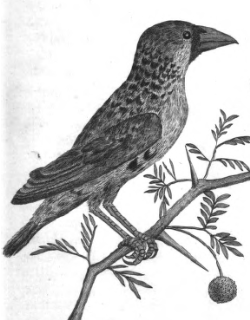
figure from Paterson 1789 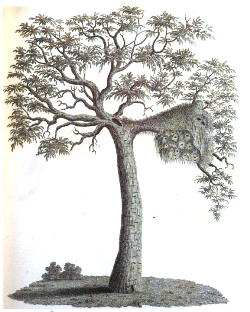
figure from Paterson 1789 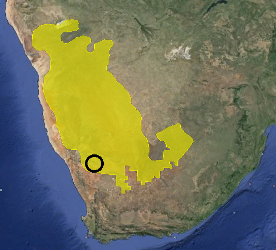
distribution, type locality circled IntroductionThe Sociable Weaver was formally described by John Latham, a Scottish explorer. Latham based the details on a travel book by William Paterson, a Scottish soldier and explorer. Paterson was sent to the Cape Colony to collect plants, and he made four trips into the interior between May 1777 and March 1780. In his published narrative, he wrote mostly about plants and rarely about animals. However, on his journey to the Orange River in 1779, he described a giraffe and the Sociable Weaver.Paterson provided the first description and illustrations of the Sociable Weaver and its massive communal nest. He compared the nest to a thatched roof which he considered an "aerial city". He saw many large nests and estimated one to have 800-1000 birds living in it. Paterson wrote about the Sociable Weaver in December 1779 after having returned from Namibia, so the exact locality is not clear. He noted that he saw the weavers and nests soon after seeing giraffe, and he would have seen the nests north of the Orange River between Goodhouse and Warmbad, during October 1779. The type locality was restricted to Warmbad for convenience. Soon after Paterson's journey, Le Vaillant travelled to the Orange River and also illustrated and wrote about the Sociable Weaver. He collected the first Rosy-faced Lovebirds, which he obtained at a Sociable Weaver colony. Le Vaillant thus was the first person to report weaver nests being used by non-weavers. Thereafter, many travellers in southern Africa wrote about the Sociable Weaver and its unique nest. Scientific citationLoxia socia Latham 1790 Index Ornith., vol. i, p.381 Capitis Bonae Spei interioribus [=Inland of Cape of Good Hope], restricted to Warmbad, southern Great Namaqualand, Namibia, by MacDonald 1957.Meaning of namessocius (Latin): sharing, allied [ie sociable].First English nameSocial Grosbeak (Paterson 1789)Alternate namesRepublican Grosbeak, Sociable Grosbeak, Social Weaver.CollectorWilliam Paterson.Date collectedOctober 1779.Locality collectedCapitis Bonae Spei interioribus [=Inland of Cape of Good Hope], restricted to Warmbad, Namibia.Type specimensType specimen not known to exist; the illustration of Paterson 1789 serves as a type. |
The above is based on Weaver Wednesday 2, a weekly series about the discovery of each weaver species.
This species text first appeared as
Weaver Wednesday [137] - Discovery [20]: Sociable Weaver on 2015-01-28
1. Basic biology

Identification.
The Sociable Weaver Philetairus socius with its huge communal nest is the iconic feature of arid regions in southern Africa. Adults are distinctive with scaled upperparts and flanks, black bib and brown cap. Juveniles lack the bib.
Distribution. The distribution map (below) is based on The Atlas of southern African Birds, showing the current PHOWN records. There have been very slight range expansions at the edges of its range in some parts (e.g. see here), although the southernmost colony has not changed in 21 years (e.g. see here). The Sociable Weaver is expected to expand its range as climate change results in an expansion of the arid region in southern Africa. Several subspecies have been described for this species in the past, but are no longer considered valid. Habitat. This species is found in open, arid country with scattered trees. Food. It forages on the ground, feeding on seeds and insects, especially harvester termites. They forage within 1.5 km of their nest sites which they occupy year-round. Breeding. The nest of the Sociable Weaver is remarkable. It may be the largest nest in the avian world, although other contenders have been considered. Nests may be up to 7m diameter, with a weight up to 1 ton. The nests are built of dry grass and nest masses would not survive in areas of high rainfall. Birds huddle together in chambers on cold winter nights to raise the temperature within the chamber. During hot summer days, birds shelter in the cool shade of the chambers. Nest sites are mainly camel thorn trees but other tree species are also used, as is the quiver tree (photo below left, phown 1103). Man-made structures are often used, particularly telephone poles. Interesting nest sites were on a dilapidated rondavel (photo below center, phown 1030) and on windmill blades (photo below right, phown 1577).    Sociable Weaver nests provide shelter and nest sites for many other birds, particularly the Pygmy Falcon which is dependant on this weaver in southern Africa (e.g. see Tswalu survey). Some other species that regularly roost or breed in the Sociable Weaver nests are Acacia Pied Barbet, Rosy-faced Lovebirds and Red-headed Finches see photos here).
|
The above is based on Weaver Wednesday, a weekly series about weaver species.
This species text first appeared as
Weaver Wednesday [16]: Sociable Weaver on 2012-10-03
2. Breeding facts
| Pair bond Monogamous, but successive nesting attempts often with different partners, even if former mate still present in colony. often breeds co-operatively, with up to nine helpers (both adults and young) Breeding season Dec-Aug in N Namibia and Nov-Jan in SE of range; elsewhere breeding not seasonal, dependent on irregular rainfall, continued over 9-month period Nest site placed 3.5-7 m above ground in tree such as Acacia erioloba, Acacia haematoxylon, Acacia giraffae, Boscia albitrunca, mopane (Colophospermum mopane) or Aloe dichotoma, occasionally exotic tree utilized, and once nest placed on small cliff; in treeless areas, telephone poles used since 1949 (baskets fitted on pole to avoid nest mass being built around insulators) and recently also electricity pylons (nest usually low, within 4 m of ground) Nest building material added throughout year Colony size up to several hundred individuals at a single nest; roof over separate nesting chambers (up to 95) Clutch size 2-6 (mean of 32 clutches 3.6) Egg colour dull white, densely spotted with different shades of grey Egg size average size of 76 eggs 20.9 x 15.1 mm (South Africa) Incubation by both sexes, period 13-14 days Chicks and nestling period fed by both parents and by helpers, nestling period 21-24 days |
Breeding information based on Handbook of the Birds of the World, Vol. 15.
3. Photos of Weaver Nests
 Vm 31396 |  Vm 31390 |  Vm 31388 |  Vm 31387 |  Vm 31385 |  Vm 31377 |
Thumb-nails of most recent PHOWN records - click on one to see its full record
See all PHOWN records for this species here.
PHOWN (Photos of Weaver Nests) provides valuable info on breeding distribution and colony sizes of weavers.
You can contribute by registering and submitting photos at Virtual Museum webpage.
4. Breeding distribution
Google map showing distribution (For species with small ranges you need to zoom in at the correct area to see the range):
yellow blob - range of weaver species; read more about this here.
![]() - PHOWN records with photos
- PHOWN records with photos
![]() - PHOWN records with no photos (Nest Record Cards, other records)
- PHOWN records with no photos (Nest Record Cards, other records)
![]() - Birdpix records
- Birdpix records
![]() - comments on out of range records, or interesting records
- comments on out of range records, or interesting records
![]() - type locality
- type locality
CLICK on the marker on the map to see individual record details.
5. Range changes
Read more in Biodiversity Observations.
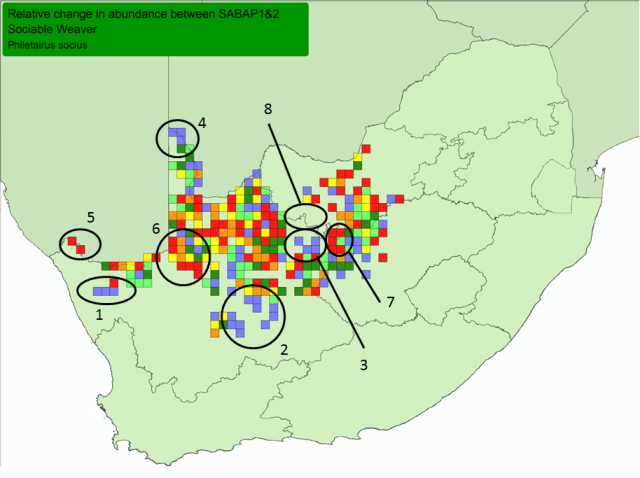
Red, orange and yellow = cells with very large, large, and small relative decreases Blue, dark green and light green = cells with very large, large and small relative increases. Cells = quarter-degree grid cells; Only cells with at least 4 checklists in both SABAP1&2 shown. All cells had this species recorded in SABAP1 or in SABAP2 or in both (more about interpretation at Biodiversity Observations 7.62: 1-13). Range changes in SA
figure from Birdpix
Areas with very large increases include:
Large decreases appear to have occurred:
8. Absent on the Ghaap plateau:
Range changes elsewhereBotswana: range extension near Konkwe Pan (Tyler 2008c). | |||||||||||||||||||||||||||||||||||
The above is based on Weaver Wednesday 3, a weekly series about range changes in South African weaver species.
This species text first appeared as
Weaver Wednesday 3 [240] - Range changes [3]: Sociable Weaver on 2017-01-18








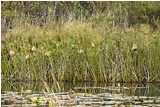


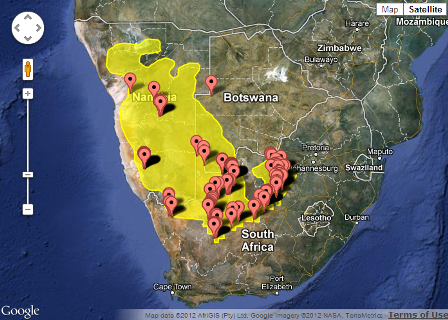
 Ideally nest records submitted to PHOWN should include a nest count, where possible, to obtain a rough guide to the colony size. For Sociable Weavers, this means counting the individual chambers by walking underneath the nest mass. Presence of snakes, however, is a good reson not to count nest chambers - Cape Cobras often raid eggs and chicks in Sociable Weaver nests, as seen in this photo (left, from
Ideally nest records submitted to PHOWN should include a nest count, where possible, to obtain a rough guide to the colony size. For Sociable Weavers, this means counting the individual chambers by walking underneath the nest mass. Presence of snakes, however, is a good reson not to count nest chambers - Cape Cobras often raid eggs and chicks in Sociable Weaver nests, as seen in this photo (left, from